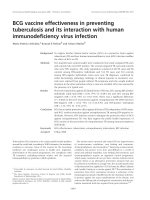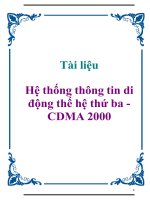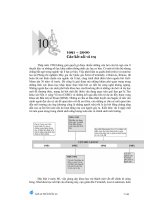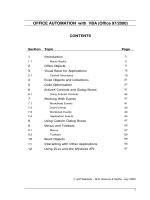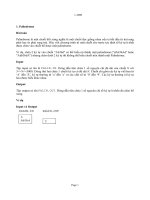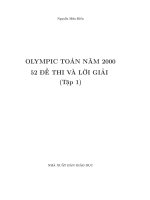D1452 80(reapproved 2000)
Bạn đang xem bản rút gọn của tài liệu. Xem và tải ngay bản đầy đủ của tài liệu tại đây (23.51 KB, 2 trang )
Designation: D 1452 – 80 (Reapproved 2000)
Standard Practice for
Soil Investigation and Sampling by Auger Borings1
This standard is issued under the fixed designation D 1452; the number immediately following the designation indicates the year of
original adoption or, in the case of revision, the year of last revision. A number in parentheses indicates the year of last reapproval. A
superscript epsilon (e) indicates an editorial change since the last revision or reapproval.
This standard has been approved for use by agencies of the Department of Defense.
a means of attaching a shaft or extension at the opposite end.
3.1.1.2 Ship-Type Auger—Similar to a carpenter’s wood bit.
It is generally forged from steel and machined to the desired
size and configuration. It is normally provided with sharpened
and hardened nibs at the point end and with an integral shaft
extending through its length for attachment of a handle or
extension at the opposite end.
3.1.2 Open Tubular Augers, ranging in size from 1.5
through 8 in. (38.1 through 203.2 mm) and having the common
characteristic of appearing essentially tubular when viewed
from the digging end.
3.1.2.1 Orchard-Barrel Type, consisting essentially of a tube
having cutting lips or nibs hardened and sharpened to penetrate
the formation on one end and an adaptor fitting for an extension
or handle on the opposite end.
3.1.2.2 Open-Spiral Type, consisting of a flat thin metal strip
that has been helically wound around a circular mandrel to
form a spiral in which the flat faces of the strip are parallel to
the axis of the augered hole. The lower helix edges are
hard-faced to improve wear characteristics. The opposite end is
fitted with an adaptor for extension.
3.1.2.3 Closed-Spiral Type—Nearly identical to the openspiral type except the pitch of the helically wound spiral is
much less than that of the open-spiral type.
3.1.3 Post-Hole Augers, generally 2 through 8 in. (50.8
through 203.2 mm), and having in common a means of
blocking the escape of soil from the auger.
3.1.3.1 Clam-Shell Type, consisting of two halves, hinged to
allow opening and closing for alternately digging and retrieving. It is not usable deeper than about 3.5 ft (1.07 m).
3.1.3.2 Iwan Type, consisting of two tubular steel segments,
connected at the top to a common member to form a nearly
complete tube, but with diametrically opposed openings. It is
connected at the bottom by two radial blades pitched to serve
as cutters which also block the escape of contained soil.
Attachment of handle or extension is at the top connector.
3.2 Machine-Operated Augers:
3.2.1 Helical Augers, generally 8 through 48 in. (203.2
through 1219 mm), consisting essentially of a center shaft
fitted with a shank or socket for application of power, and
having one to three complete 360° (6.28-rad) spirals for
conveyance and storage of cut soil. Cutter bits and pilot bits are
available in moderate and hard formation types and normally
replaceable in the field. They are normally operated by
1. Scope
1.1 This practice covers equipment and procedures for the
use of earth augers in shallow geotechnical exploration. This
practice does not apply to sectional continuous flight augers.
1.2 This standard does not purport to address all of the
safety concerns, if any, associated with its use. It is the
responsibility of the user of this standard to establish appropriate safety and health practices and determine the applicability of regulatory limitations prior to use.
1.3 This practice offers a set of instructions for performing
one or more specific operations. This document cannot replace
education or experience and should be used in conjunction
with professional judgment. Not all aspects of this practice may
be applicable in all circumstances. This ASTM standard is not
intended to represent or replace the standard of care by which
the adequacy of a given professional service must be judged,
nor should this document be applied without consideration of
a project’s many unique aspects. The word “Standard” in the
title of this document means only that the document has been
approved through the ASTM concensus process.
2. Significance and Use
2.1 Auger borings often provide the simplest method of soil
investigation and sampling. They may be used for any purpose
where disturbed samples can be used and are valuable in
connection with ground water level determination and indication of changes in strata and advancement of hole for spoon
and tube sampling. Equipment required is simple and readily
available. Depths of auger investigations are, however, limited
by ground water conditions, soil characteristics, and the
equipment used.
3. Apparatus
3.1 Hand-Operated Augers:
3.1.1 Helical Augers—Small lightweight augers generally
available in sizes from 1 through 3 in. (25.4 through 76.2 mm).
3.1.1.1 Spiral-Type Auger, consisting of a flat thin metal
strip, machine twisted to a spiral configuration of uniform
pitch; having at one end, a sharpened or hardened point, with
1
This practice is under the jurisdiction of ASTM Committee D18 on Soil and
Rock and is the direct responsibility of Subcommittee D18.02 on Sampling and
Related Field Testing for Soil Investigations.
Current edition approved June 12, 1980. Published August 1980. Originally
published as D 1452 – 57 T. Last previous edition D 1452 – 65 (1972).
Copyright © ASTM, 100 Barr Harbor Drive, West Conshohocken, PA 19428-2959, United States.
1
D 1452
used. The casing shall be driven to a depth not greater than the
top of the next sample and shall be cleaned out by means of the
auger. The auger can then be inserted into the bore hole and
turned below the bottom of the casing to obtain a sample.
4.3 The soil auger can be used both for boring the hole and
for bringing up disturbed samples of the soil encountered. The
structure of a cohesive soil is completely destroyed and the
moisture may be changed by the auger. Seal all samples in a jar
or other airtight container and label appropriately. If more than
one type of soil is picked up in the sample, prepare a separate
container for each type of soil.
4.4 Field Observations—Record complete ground water
information in the field logs. Where casing is used, measure
ground water levels both before and after the casing is pulled.
In sands, determine the water level at least 30 min after the
boring is completed; in silts, at least 24 h. In clays, no accurate
water level determination is possible unless pervious seams are
present. As a precaution, however, water levels in clays shall be
taken after at least 24 h.
heavy-duty, high-torque machines, designed for heavy construction work.
3.2.2 Stinger Augers, generally 6 through 30 in. (152.4
through 762 mm), are similar to the helical auger in 3.2.1, but
lighter and generally smaller. They are commonly operated by
light-duty machines for post and power pole holes.
3.2.3 Disk Augers, generally 10 through 30 in. (254 through
762 mm), consisting essentially of a flat, steel disk with
diametrically opposed segments removed and having a shank
or socket located centrally for application of power. Replaceable cutter bits, located downward from the leading edges of
the remaining disk, dig and load soil that is held on the disk by
valves or shutters hinged at the disk in order to close the
removed segments. The disk auger is specifically designed to
be operated by machines having limited vertical clearance
between spindle and ground surface.
3.2.4 Bucket Auger, generally 12 through 48 in. (304.8
through 1219 mm), consisting essentially of a disk auger,
without shank or socket, but hinge-mounted to the bottom of a
steel tube or bucket of approximately the same diameter as the
disk auger. A socket or shank for power application is located
in the top center of the bucket diametral cross piece provided
for the purpose.
3.3 Casing (when needed), consisting of pipe of slightly
larger diameter than the auger used.
3.4 Accessory Equipment—Labels, field log sheets, sample
jars, sealing wax, sample bags, and other necessary tools and
supplies.
5. Report
5.1 The data obtained in boring shall be recorded in the field
logs and shall include the following:
5.1.1 Date of start and completion of boring,
5.1.2 Identifying number of boring,
5.1.3 Reference datum including direction and distance of
boring relative to reference line of project or other suitable
reference points,
5.1.4 Type and size of auger used in boring,
5.1.5 Depth of changes in strata,
5.1.6 Description of soil in each major stratum,
5.1.7 Ground water elevation and location of seepage zones,
when found, and
5.1.8 Condition of augered hole upon removal of auger, that
is, whether the hole remains open or the sides cave, when such
can be observed.
4. Procedure
4.1 Make the auger boring by rotating and advancing the
desired distance into the soil. Withdraw the auger from the hole
and remove the soil for examination and test. Return the empty
auger to the hole and repeat the procedure. Continue the
sequence until the required depth is reached.
4.2 Casing is required in unstable soil in which the bore hole
fails to stay open and especially when the boring is extended
below the ground-water level. The inside diameter of the
casing must be slightly larger than the diameter of the auger
6. Keywords
6.1 auger borings; sampling; soil investigations
The American Society for Testing and Materials takes no position respecting the validity of any patent rights asserted in connection
with any item mentioned in this standard. Users of this standard are expressly advised that determination of the validity of any such
patent rights, and the risk of infringement of such rights, are entirely their own responsibility.
This standard is subject to revision at any time by the responsible technical committee and must be reviewed every five years and
if not revised, either reapproved or withdrawn. Your comments are invited either for revision of this standard or for additional standards
and should be addressed to ASTM Headquarters. Your comments will receive careful consideration at a meeting of the responsible
technical committee, which you may attend. If you feel that your comments have not received a fair hearing you should make your
views known to the ASTM Committee on Standards, at the address shown below.
This standard is copyrighted by ASTM, 100 Barr Harbor Drive, PO Box C700, West Conshohocken, PA 19428-2959, United States.
Individual reprints (single or multiple copies) of this standard may be obtained by contacting ASTM at the above address or at
610-832-9585 (phone), 610-832-9555 (fax), or (e-mail); or through the ASTM website (www.astm.org).
2



